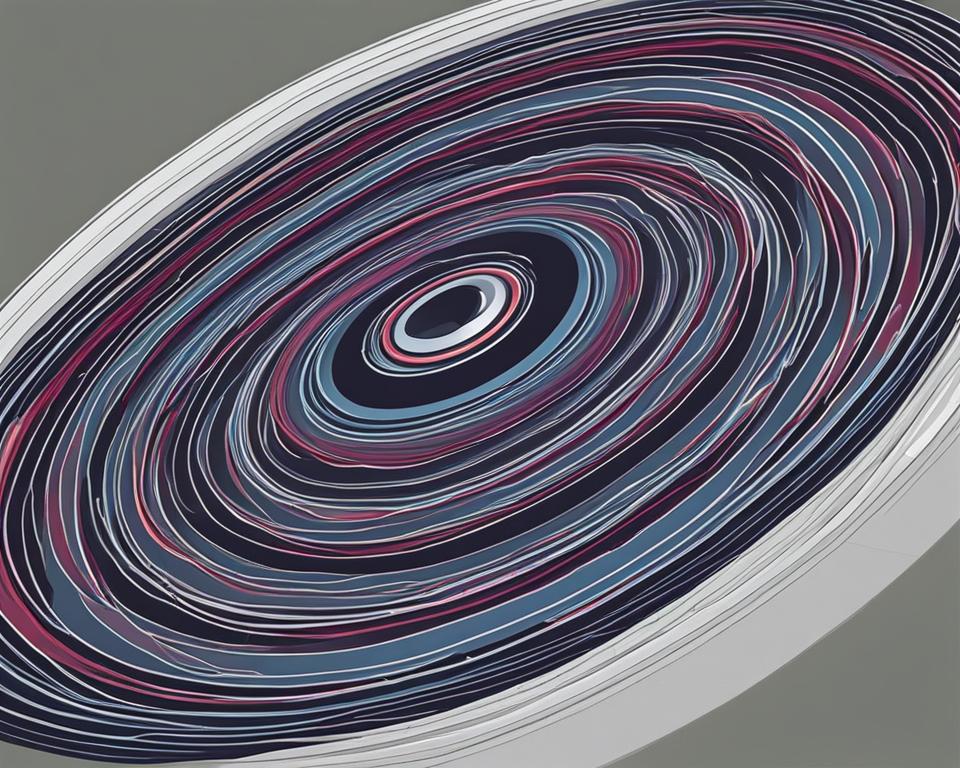Welcome to our article on the difference between an oval and an ellipse. While these two shapes may appear similar at first glance, they have distinct characteristics and properties that set them apart. In this article, we will explore the defining features of ovals and ellipses, as well as their definitions and usage examples. So let’s dive in and discover the fascinating world of oval and ellipse shapes.

Key Takeaways:
- An oval is a curved, closed shape with a slightly tapered end on one side.
- An ellipse is a curved, closed shape with uniformly tapered sides, giving it a balanced and symmetrical look.
- Ovals do not have the symmetry of their axes or a center, while ellipses have a symmetrical shape and a center.
- Ovals do not have fixed or focal points, while ellipses have two focal points on the major axis.
- Understanding the differences between ovals and ellipses can help in accurately identifying and classifying these shapes.
Differences Between Oval and Ellipse
Ovals and ellipses are two curved, closed shapes that share similarities but also have distinct characteristics that set them apart.
One of the main differences between an oval and an ellipse is their symmetry. An oval does not satisfy the symmetry of its axes, while an ellipse has a symmetrical shape. This means that the sides of an oval are not uniformly tapered, unlike an ellipse which has balanced sides.
Another difference is how these shapes are formed. Ovals are formed from arcs from three unequal circles, while ellipses are formed from a straight plane intersecting a right circular cone at an angle greater than zero. This difference in formation contributes to the varying shapes and properties of ovals and ellipses.
In terms of focal points, ovals do not have fixed or focal points, whereas ellipses have two focal points on the major axis. This property of ellipses allows them to have unique applications in physics, such as in the orbits of planets in the solar system and reflectors for antennae.
| Characteristic | Oval | Ellipse |
|---|---|---|
| Symmetry | Not symmetrical | Symmetrical |
| Formation | Formed from arcs from three unequal circles | Formed from a straight plane intersecting a right circular cone at an angle greater than zero |
| Focal Points | No focal points | Two focal points on the major axis |
Definition of Oval and Ellipse
Understanding the definition of oval and ellipse is crucial to distinguishing between these two curved, closed shapes. Let’s explore their characteristics in detail.
Oval Definition:
An oval is a curved, closed shape with a slightly tapered end on one side. It resembles the shape of an egg, with its elongated form and rounded curves. However, unlike an ellipse, an oval does not have the symmetry of its axes (major and minor) or a center. Additionally, an oval does not have fixed or focal points, which are key properties of an ellipse.
Ellipse Definition:
An ellipse is also a curved, closed shape, but its sides are uniformly tapered, giving it a balanced and symmetrical appearance. It can be visualized as a stretched or squeezed circle. Unlike an oval, an ellipse satisfies the symmetry of its axes, with the major and minor axes being of equal length. Furthermore, an ellipse has a center and two focal points on the major axis, which are essential properties distinguishing it from an oval.
By understanding the unique definitions of oval and ellipse, we can accurately identify and classify these shapes based on their characteristics.
| Characteristics | Oval | Ellipse |
|---|---|---|
| Symmetry of Axes | No symmetry | Symmetrical shape |
| Formation | Formed from arcs from three unequal circles | Formed from a straight plane intersecting a right circular cone at an angle greater than zero |
| Center | No center | Has a center |
| Fixed/Focal Points | No fixed/focal points | Two focal points on the major axis |
Usage and Examples of Oval and Ellipse
Ovals and ellipses are versatile shapes that find applications in various fields. While ovals are not precisely defined geometrical figures in mathematics, they can be recognized as figures when a circle is stretched on two opposite ends, resembling the shape of an egg or an ellipse. On the other hand, ellipses have many practical uses, especially in physics and astronomy.
One of the primary applications of ellipses is in describing the orbits of celestial bodies. In the solar system, the planets follow elliptical paths around the sun. These elliptical orbits help maintain the balance and stability of the solar system. Ellipses also find applications in reflectors for antennae and as acoustic devices where they are used to focus sound waves.
Mathematically, both ovals and ellipses offer interesting examples of curved shapes. Ovals can be seen in various mathematical shapes such as Cassini ovals, elliptic curves, super-ellipses, and Cartesian ovals. These shapes have unique properties and serve as fascinating subjects for mathematical study. On the other hand, ellipses are prevalent in nature, with examples ranging from the orbits of planets to the shape of galaxies.
“Ellipses are not only scientifically significant but also visually captivating. Their symmetrical and balanced appearance makes them aesthetically pleasing to the eye.”
The Versatility of Ovals and Ellipses
The versatility of ovals and ellipses can be further demonstrated through a comparison of their characteristics:
| Characteristic | Oval | Ellipse |
|---|---|---|
| Symmetry | No symmetry of axes | Symmetrical shape |
| Formation | Arcs from three unequal circles | Straight plane intersecting a right circular cone at an angle greater than zero |
| Center | No center | Has a center |
| Focal Points | No fixed or focal points | Two focal points on the major axis |
| Focal Point Properties | Does not satisfy properties of focal points | Satisfies properties of focal points |
Understanding the usage and characteristics of ovals and ellipses can enhance our understanding of these intriguing shapes and their applications in various fields.
Conclusion
In conclusion, ovals and ellipses are two distinct curved shapes that may appear similar at first glance. However, they have significant differences that set them apart.
An oval is characterized by its curved, closed shape with a slightly tapered end on one side. On the other hand, an ellipse has uniformly tapered sides, giving it a balanced geometric appearance.
Furthermore, while an oval lacks the symmetry of its axes and does not have a center or fixed focal points, an ellipse possesses a symmetrical shape and two focal points on the major axis. These properties contribute to the unique characteristics of the ellipse.
Understanding the differences between ovals and ellipses is crucial in correctly identifying and classifying these shapes. Whether it’s in mathematics, physics, or simply appreciating the beauty of these forms, recognizing their distinctions allows for a deeper understanding of their significance.
FAQ
What is the difference between an oval and an ellipse?
An oval is a curved, closed shape with a slightly tapered end on one side, while an ellipse has uniformly tapered sides, giving it a balanced look geometrically.
Do ovals and ellipses have different shapes?
Yes, the shape of an oval is similar to that of an egg, while an ellipse is like a stretched or squeezed circle.
Do ovals and ellipses have different symmetries?
Yes, an oval does not satisfy the symmetry of its axes (major and minor), while an ellipse has a symmetrical shape.
Do ovals and ellipses have different centers?
Yes, an oval does not have a center, while an ellipse has a center.
Do ovals and ellipses have different focal points?
Yes, an oval has no fixed or focal points, while an ellipse has two focal points on the major axis.
Are ovals and ellipses used in different applications?
Yes, examples of ovals can be seen in various mathematical shapes such as Cassini ovals, elliptic curves, super-ellipses, and Cartesian ovals, while examples of ellipses can be seen in celestial bodies such as the orbits of planets in the solar system.
Can ovals and ellipses be classified as precise geometric figures?
Ovals are not always precisely defined geometrical figures in mathematics, but they can be recognized as figures when a circle is stretched on two opposite ends, resembling the shape of an egg or an ellipse.
What are some examples of ovals and ellipses?
Examples of ovals can be seen in various mathematical shapes such as Cassini ovals, elliptic curves, super-ellipses, and Cartesian ovals. Examples of ellipses can be seen in celestial bodies such as the orbits of planets in the solar system.
Why is it important to understand the differences between ovals and ellipses?
Understanding the differences between ovals and ellipses can help in identifying and classifying these shapes correctly.
